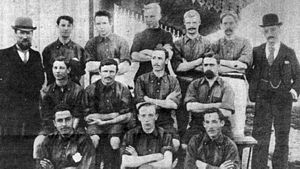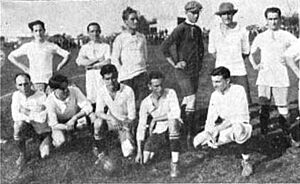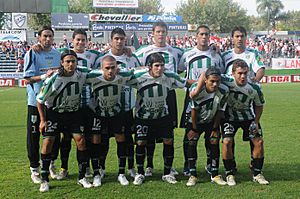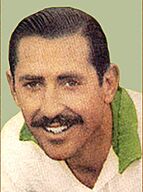Club Atlético Banfield facts for kids
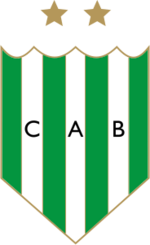 |
||||
| Full name | Club Atlético Banfield | |||
|---|---|---|---|---|
| Nickname(s) | El Taladro (The Drill) | |||
| Founded | 21 January 1896 | |||
| Ground | Estadio Florencio Solá | |||
| Capacity | 34,901 | |||
| Chairman | Matías Mariotto | |||
| Manager | Pedro Troglio | |||
| League | Primera División | |||
| 2024 | 27th | |||
|
||||
Club Atlético Banfield is a sports club from Banfield, a city near Buenos Aires, Argentina. It was started on January 21, 1896, by British people living there. The club is most famous for its football (soccer) teams. They play in the Primera División, which is the top football league in Argentina.
In 2009, Banfield won its first Primera División title. This was a huge achievement for the club. They also won a national cup in 1920, called the Copa de Honor Municipalidad de Buenos Aires. They beat Boca Juniors 2–1 in that final. Banfield has also won 10 titles in the Second Division.
The "Southern Classic" ("Clásico del Sur") is a big rivalry game for Banfield. They play against Lanús. This match is one of the most exciting in Argentine football. Banfield also has rivalries with other teams like Los Andes and Temperley. In 2018, Lucía Barbuto became the first woman president of a top-division football club in Argentina. Banfield also has a women's football team, which started in 1997.
Besides football, the club offers many other sports. These include boxing, chess, field hockey, futsal, gymnastics, handball, roller skating, taekwondo, tennis, and volleyball.
| Top - 0-9 A B C D E F G H I J K L M N O P Q R S T U V W X Y Z |
Club History
How Banfield Started
In the late 1800s, many British families moved to Banfield, a town south of Buenos Aires. They built English-style houses and brought their traditions. On January 21, 1896, some English business people in Banfield decided to start a club. They named it after the town. The town itself was named after Edward Banfield, a railway manager.
Daniel Kingsland and George Burton were key founders. Kingsland was the first president. At first, cricket was the main sport. Football was not as popular, and the team didn't do well in early championships. They even lost some games by a lot, like 0–10.
Early Football Wins
Things changed in 1899 when Alfredo Goode, a football fan, became president. In 1899, Banfield won its first football title. They became champions of the Second Division. Banfield is the only club still part of the Argentine Football Association (AFA) that won a title in the 1800s.
Most of the players were from Great Britain. The team won the Second Division championship again in 1900, this time without losing any games. Key players included Edward "Invincible" Potter and captain James Dodds Watson.
After these wins, the club faced some tough times. But in 1904, it was reorganized. George Burton, another football lover, led the club for many years until he passed away in 1928.
In 1908, Banfield's third-division team won their championship. In 1912, they won the third category championship again. This helped them move up to the second division. A change in the league system then sent Banfield directly to the top division.
Banfield played well in 1913 and 1914. However, when World War I started, many British players joined the army. This affected the team. In 1919, Banfield returned to the first division.
The 1920s: A Big Cup Win
After being promoted, Banfield finished second in the league in 1920. That same year, they played in the Buenos Aires municipal honor cup. Banfield made it to the final and beat Boca Juniors. They came back from being down 1–0 to win 2–1. This was their first major title!
In 1928, George Burton, the club president for over 20 years, passed away. His death caused some challenges for the club for about ten years.
The 1930s and 1940s: Ups and Downs
In 1931, professional football leagues started in Argentina. Banfield chose to stay in the amateur league, thinking professionalism wouldn't last. Many of their players left for professional clubs.
With fewer players, Banfield struggled. In 1935, they joined the professional AFA and were placed in the Second Division. They had poor seasons and were even relegated to a lower division in 1938.
Later in 1938, a young businessman named Florencio Sola became president. He helped Banfield avoid dropping further down. The team won a special tournament and was promoted back to the Primera División in 1939.
In 1940, Banfield had a new team with strong players. A newspaper called them "El Taladro" ("The Drill"). This nickname stuck because they "drilled" through their opponents' defenses.
The club's stadium, later named "Florencio Sola," was built in 1940. In 1941, Banfield faced a penalty but managed to stay in the top division. After being relegated in 1944, they won the Second Division championship again in 1946.
Florencio Sola became president again in 1948. He brought in new players. The team almost got relegated again, but a player strike meant youth players had to play. Banfield's coach, Renato Cesarini, helped them win games and stay in the top division.
1950s and 1960s: Strong Teams
In 1951, Banfield finished first in the league. They had to play a tie-breaker against Racing Club and lost, but many called them the "moral champions" because they had a better goal difference.
The team continued to play well, finishing fifth in 1952. However, after losing a key player in 1953, they were relegated in 1954. Florencio Sola stepped down as president.
Between 1950 and 1953, Banfield had an amazing record at home. They went 49 games without losing! Many talented young players came from the club's youth teams during this time.
In 1962, Banfield was promoted back to the First Division after a great season. They had strong players like Ediberto Righi and Norberto Raffo. From 1963, they stayed in the First Division for 16 seasons, except for one year in 1973.
The "Drill" had excellent seasons in 1963 and 1964. They continued to bring in good players. In 1968, Banfield won the Promotional Tournament. In 1969, they avoided relegation by winning a special reclassification game.
1970s and 1980s: Promotions and Relegations
In 1972, Banfield was relegated again. But they quickly bounced back! In 1973, they won the First B (second division) championship and were promoted. Key players included Ricardo La Volpe and Juan Alberto Taverna.
On October 6, 1974, Banfield achieved their biggest win ever. They defeated Puerto Comercial de Bahía Blanca 13–1! This is the highest score in a single game in Argentina's top division. Juan Alberto Taverna scored seven goals in that match, which is also a record.
After returning to the First Division, Banfield played very well in 1976. They had a strong attacking team. But this success didn't last long. In 1978, they had a poor season and were relegated again after losing a tie-breaker.
In 1985, coach Angel Cappa joined the club. He built the team that won a playoff in 1987 to get promoted. This team had a mix of experienced players and young talents from the club's youth system.
1990–1999: Rebuilding the Team
The early 1990s were tough for Banfield. They were often in the relegation zone. In the 1992–93 season, with Valentín Suárez back as president, Banfield hired Carlos Babington as coach. They also brought in experienced players and relied on talented young players like Javier Sanguinetti. Sanguinetti went on to play the most games for the club, over 450!
This team won the Second Division title and was promoted to the Primera División. They beat Colón de Santa Fe in a penalty shootout in the final.
Back in the top league, Banfield had good seasons at first. A young player named Javier Zanetti became a star for the team. However, they couldn't keep up their good performance and were relegated again in 1997.
In 1998, Carlos Portel became the new president. The club was facing financial difficulties, and his main goal was to reduce the club's debts.
The Falcioni Era: A Championship Win!
In 2001, Banfield returned to the Primera División. They won a special playoff series against Quilmes. José Luis Garrafa Sánchez was a very important player for the team.
In 2003, Julio César Falcioni became the coach. He helped develop key players like Daniel Bilos and Rodrigo Palacio. Banfield had a great season in 2003–04, finishing third. This allowed them to play in international tournaments like the 2004 Copa Sudamericana and 2005 Copa Libertadores. In the Copa Libertadores, they reached the quarterfinals, which was a big achievement.
During this time, Banfield played in 5 international cups in 3 years. They became one of the top 8 teams in South America. This success also helped the club build new parts of their stadium.
In 2009, with Falcioni still as coach, Banfield had an amazing season. They started strong, beating tough teams. As the season went on, Banfield held onto the top spot, with Newell's Old Boys close behind.
On December 13, 2009, Banfield lost their last game to Boca Juniors. But because Newell's Old Boys also lost, Banfield won their first-ever championship in the top division of Argentine football! About 40,000 fans celebrated at their stadium. It was a dream come true for the club and its supporters.
After winning the title, Banfield played in the 2010 Copa Libertadores. They made it to the knockout stage but were eliminated by Internacional. Falcioni later resigned and became coach of Boca Juniors.
Decline and Relegation
After Falcioni left, Banfield struggled. They changed coaches several times, but the team's performance didn't improve. In June 2012, Banfield was relegated to the second division (Primera B Nacional). They had finished last in the previous two tournaments.
After the relegation, the club's president and other leaders resigned. A new election was held, and Eduardo Spinosa became the new chairman.
Rebuilding the Club
In the 2012–2013 season, playing in the Second Division, Banfield almost got promoted. Matías Almeyda took over as coach and helped many young players from the club's youth teams get a chance to play.
For the 2013–14 season, Almeyda built a very strong team. Players like Nicolás Bertolo and Walter Erviti returned to the club. Banfield won the Second Division title easily and was promoted back to the First Division. They secured promotion with a 1–1 draw against Douglas Haig and won the title by beating Talleres 2–1.
Back in the First Division in 2014, Banfield had a good season for a newly promoted team. They even beat the American champion San Lorenzo.
Return to International Competitions
In 2015, with 30 teams in the First Division, Banfield aimed to return to international competitions. They played well and qualified for the Copa Sudamericana in 2016.
In 2016, Banfield celebrated 120 years. Many young players became important for the first team. Julio Falcioni also returned as coach.
The 2016–17 season was great for Banfield. They had many young players and experienced leaders. They fought for the championship and qualified for the Copa Libertadores.
In the 2017–18 season, Banfield prepared for the Copa Libertadores. They brought back Jesús Datolo, another player who grew up in the club. More young players joined the first team. After playing in the Copa Libertadores, Banfield also qualified for the Copa Sudamericana in 2018.
Club Symbols
Green and White Colors
The colors of Banfield Athletic Club were originally brown and old gold. These colors might have been linked to railway danger signs. Later, in 1903–1904, the club used shirts with red and white squares.
In 1904, the club officially adopted white and green. Some believe the green came from the Irish players. Since 1907, Banfield's main jersey has been green and white stripes. Over the years, there have been some changes. For example, in the 1970s, they added orange to their away kits, inspired by the famous Dutch national team. Today, orange is still sometimes used with green and white on their alternate jerseys.
The Drill Nickname
In 1940, Florencio Sola completely rebuilt the team. With new players, Banfield had a surprising season for a newly promoted club. The newspaper El Pampero nicknamed them "the Drill" (El Taladro). This was because they "drilled" holes in their opponents' defenses by scoring many goals. This nickname became the club's official symbol.
Another idea is that the nickname came from the team "drilling" the big teams, meaning they made them drop down in the league standings.
Julio César Falcioni
Julio César Falcioni has coached Banfield four times. He is considered the club's biggest hero because he led them to their first top-division championship. Banfield fans love his coaching style, which they call "Falcionismo." A popular flag at the stadium says: "The happiest days were always Falcionistas."
Supporters
Banfield fans are known as La Banda del Sur (The Southern Gang). Most fans come from the Banfield area and other southern neighborhoods of Greater Buenos Aires. You can find Banfield fans all over the south of Buenos Aires. A survey in 1998 suggested that Banfield had about 104,000 fans in Argentina.
Classic Matches and Rivalries
Classic Matches
The biggest rivalry for Banfield is against Lanús. This match is called the Clásico del Sur (Southern Classic). This rivalry became very important in the late 1980s and early 1990s.
The second most important classic for Banfield fans is against Quilmes. Quilmes is another team from the southern part of Buenos Aires.
Other Rivalries
Banfield also has important rivalries with Temperley, Talleres (RdE), El Porvenir, Los Andes, Defensa y Justicia, and Arsenal de Sarandí. These are all teams from the same general area.
From other parts of the region, Banfield also has rivalries with Morón (West Zone) and Nueva Chicago (Federal Capital).
Uniform Evolution
|
|
|
|
|
Stadium

The Florencio Sola stadium was built in 1940. It is named after Florencio "Lencho" Sola, a former club president during a very successful time.
To celebrate its opening, Banfield played a match against Independiente de Avellaneda. Banfield lost 1–0. At this stadium, the "Drill" had an amazing record of 39 matches without losing from 1950 to 1953. The stadium was considered very modern for its time. It was one of the first "medium" clubs to have concrete stands.
The stadium is located in Banfield city. It recently added new sections, including boxes and booths for radio and TV. The stadium can hold 34,901 fans.
Club Headquarters
The club's main office is in Banfield. This is where athletes meet for different activities. Club meetings are also held here.
At the headquarters, training for other sports like volleyball, futsal, and taekwondo takes place. There is also a gym and a team room open to the public where fans gather.
Team Records
- Seasons in first division: 73
- Biggest win achieved:
- Biggest defeats:
- First division: 1–8 to Estudiantes La Plata (June 1, 1947).
- Primera B: 0–6 to Argentino de Rosario (1945).
- In international tournaments: 0–4 to
 Club América (March 7, 2007).
Club América (March 7, 2007).
- Best league position: 1st (champion) in 2009 Apertura.
- Worst league position: 19th.
- Top Scorer: Gustavo Albella: 136 goals (1945–51, 1954).
- Player with most appearances: Javier Sanguinetti: 493 games (1989–93, 1994–2008).
- International participations:
- Copa Sudamericana 2004: First round.
- Copa Libertadores 2005: Quarterfinals.
- Copa Sudamericana 2005: Eliminated.
- Copa Sudamericana 2006: First round.
- Copa Libertadores 2007: First round.
- Copa Libertadores 2010: Round of 16.
- Copa Sudamericana 2010: Round of 16.
- Copa Sudamericana 2016: Second Phase.
- Copa Libertadores 2018: Phase 3.
- Copa Sudamericana 2018: Round of 16.
Football Records
Banfield holds some special records in the First Division:
- Between 1950 and 1953, they went 49 games undefeated at home. This lasted for three years and 17 days.
- In the 1951 tournament, they were the first team outside of Argentina's "big five" clubs to finish first in an AFA tournament. They should have been champions based on goal difference, but they had to play two finals against Racing Club.
- They were the first team to score 5 goals against River Plate at their stadium, winning 5–1 on June 20, 1951. They scored four goals in just thirteen minutes during the second half.
- On October 6, 1974, they achieved the biggest win in professional football by defeating Puerto Comercial de Bahía Blanca 13–1. Banfield is the only team to score 13 goals in a single match. They also hold the record for the largest goal difference (12) between teams in the same category in AFA professional divisions.
- In that same match, Juan Alberto Taverna set a record by scoring seven goals in a single professional game.
- Banfield is the only club affiliated with the AFA to have won titles in three different centuries: 1800s (1899), 1900s (1920), and 2000s (2009).
- James Rodríguez of Banfield became the youngest foreign player to debut in Argentine football at age 17.
- Banfield is the first team that competed in both amateur and professional tournaments to become a champion in professional football.
Players
Current Squad
|
|
Reserve Squad
|
Out on Loan
|
Famous Players
Here are some notable players who have played for Banfield:
 Jorge Alcalde (1943–45)
Jorge Alcalde (1943–45) Herminio Masantonio (1944)
Herminio Masantonio (1944) Gustavo Albella (1945–51), (1955–56)
Gustavo Albella (1945–51), (1955–56) Juan José Pizzuti (1947–50)
Juan José Pizzuti (1947–50) Eliseo Mouriño (1948–52)
Eliseo Mouriño (1948–52)
 Ernesto Álvarez (1948–56)
Ernesto Álvarez (1948–56) Oscar López (1960–65), (1970–71)
Oscar López (1960–65), (1970–71) Norberto Raffo (1961–66)
Norberto Raffo (1961–66) Sergio Vázquez (1966)
Sergio Vázquez (1966) José Ramos Delgado (1966–67)
José Ramos Delgado (1966–67) José Sanfilippo (1966–67)
José Sanfilippo (1966–67) Jorge Carrascosa (1967–69)
Jorge Carrascosa (1967–69) Ricardo Lavolpe (1971–75)
Ricardo Lavolpe (1971–75) Silvio Sotelo (1971–78)
Silvio Sotelo (1971–78) Héctor Veira (1974)
Héctor Veira (1974) Carlos Buttice (1981–82)
Carlos Buttice (1981–82) Daniel Delfino (1988–90), (1991–93), (1995–96)
Daniel Delfino (1988–90), (1991–93), (1995–96) Javier Sanguinetti (1990–93), (1994–08)
Javier Sanguinetti (1990–93), (1994–08) Javier Zanetti (1993–95)
Javier Zanetti (1993–95) Ángel Comizzo (1993–96)
Ángel Comizzo (1993–96) Julio Cruz (1993–96)
Julio Cruz (1993–96) Néstor Lorenzo (1994–95)
Néstor Lorenzo (1994–95) Pablo Paz (1995–96)
Pablo Paz (1995–96) Guido Alvarenga (1995–96)
Guido Alvarenga (1995–96) Pedro Sarabia (1996–97)
Pedro Sarabia (1996–97) Walter Peletti (1996–97)
Walter Peletti (1996–97) Cristian Lucchetti (1996–02), (2005–10)
Cristian Lucchetti (1996–02), (2005–10)
 Mauro Camoranesi (1997–98)
Mauro Camoranesi (1997–98) Andrés San Martín (1997–99), (2002–05)
Andrés San Martín (1997–99), (2002–05) Carlos Leeb (1997–02)
Carlos Leeb (1997–02) José Luis Sánchez (1999–05)
José Luis Sánchez (1999–05) Daniel Bilos (2000–05), (2009)
Daniel Bilos (2000–05), (2009) Cristian Leiva (2001–02), (2003–06), (2012–14)
Cristian Leiva (2001–02), (2003–06), (2012–14) Josemir Lujambio (2001–02), (2005–07)
Josemir Lujambio (2001–02), (2005–07) Julio Barraza (2001–11)
Julio Barraza (2001–11)
 Roberto Colautti (2002–03)
Roberto Colautti (2002–03) Marcos Galarza (2002–09), (2012–13)
Marcos Galarza (2002–09), (2012–13) Rodrigo Palacio (2003–04)
Rodrigo Palacio (2003–04) Jorge Núñez (2003–04)
Jorge Núñez (2003–04)
 Darío Cvitanich (2003–08), (2017–19)
Darío Cvitanich (2003–08), (2017–19)
 Gabriel Paletta (2005–06)
Gabriel Paletta (2005–06) Walter Erviti (2008–10), (2014–17)
Walter Erviti (2008–10), (2014–17) James Rodríguez (2008–10)
James Rodríguez (2008–10) Sebastián Fernández (2008–10)
Sebastián Fernández (2008–10) Santiago Silva (2009), (2016)
Santiago Silva (2009), (2016)
Individual Records
Most Appearances
| No. | Player | Pos. | Years Played | Matches |
|---|---|---|---|---|
| 1 | DF | 1989–93, 1994–2008 | 493 | |
| 2 | GK | 1996–2003, 2005–10, 2011–12 | 319 | |
| 3 | GK | 1946, 1955–56, 1958–59 | 311 | |
| 4 | DF | 1971–78 | 242 | |
| 5 | FW | 1946–51, 1955–56 | 233 |
Top Scorers
| No. | Player | Pos. | Years Played | Goals |
|---|---|---|---|---|
| 1 | FW | 1946–51, 1955–56 | 136 | |
| 2 | FW | 1940–44, 1947–48 | 81 | |
| 3 | FW | 1963–66 | 68 | |
| 4 | FW | 1954–61 | 68 | |
| 5 | FW | 2003–08, 2016–18 | 65 |
Presidents
- 1896-1898 Daniel Kingsland
- 1899-1900 Alfred John Goode
- 1901 Federick James Cassini
- 1902 George Stearn
- 1903-1904 Clement August Mason
- 1905-1906 Dante Terenziani
- 1906 R. Valenzuela
- 1907-1910 George James William Burton
- 1910: J. L. Howard
- 1911: L. J. Thiesen
- 1912: Guillermo Coo
- 1913–28: G. J. W. Burton
- 1928–30: Félix Sola (h)
- 1930–32: Rafael de Seta
- 1933: Américo Pisano
- 1934: Rafael de Seta
- 1935: Francisco Ventura
- 1936: Gerardo Martínez Abal
- 1937: Américo Pisano
- 1938–44: Florencio Sola
- 1945–46: Remigio Sola
- 1947–54: Florencio Sola
- 1955: Antonio Benito Ferranti
- 1956: Enrique Beltrán Simo
- 1957–59: Alfredo Gómez
- 1960–62: Valentín Suárez
- 1963–65: Juan Carlos Fontela
- 1966–68: Valentín Suárez
- 1969: Juan Carlos Fontela
- 1970–71: Carlos Ismael Soler
- 1972–74: Valentín Suárez
- 1975–77: Osvaldo Fani
- 1978–79: Manuel Salgado
- 1980: Aniceto Rodrigo
- 1980: Juan Carlos Mori
- 1981–83: Néstor Edgardo Villar
- 1984–85: Valentín Suárez
- 1985: Miguel M. Alberdi
- 1986: Atilio Pettinati
- 1986–87: Fernando Oscar Tomás
- 1987–89: Raúl Alfonso Muñiz
- 1989–91: Julio César Grigera
- 1991–93: Valentín Suárez
- 1993–95: Carlos Fontela
- 1995–96: Raúl Alfonso Muñiz
- 1996–98: Atilio Pettinati
- 1998–2012: Carlos Portell
- 2012–2018: Eduardo Spinosa
- 2018: Lucía Barbuto
Managers
 Emilio Baldonedo
Emilio Baldonedo Dan Georgiadis (1958)
Dan Georgiadis (1958) Adolfo Pedernera (1976)
Adolfo Pedernera (1976) Norberto Raffo (1977)
Norberto Raffo (1977) Ángel Cappa (1985–86), (1987–88)
Ángel Cappa (1985–86), (1987–88) Luis Garisto (2001–03)
Luis Garisto (2001–03) Julio César Falcioni (2003–05)
Julio César Falcioni (2003–05) Pablo Sánchez (2007)
Pablo Sánchez (2007) Juan Manuel Llop (2007–08)
Juan Manuel Llop (2007–08) Jorge Burruchaga (2008–09)
Jorge Burruchaga (2008–09) Julio César Falcioni (2009–10)
Julio César Falcioni (2009–10) Sebastián Méndez (2011)
Sebastián Méndez (2011) Eduardo Acevedo (2012)
Eduardo Acevedo (2012) Daniel Garnero (2012–13)
Daniel Garnero (2012–13) Matías Almeyda (2013–15)
Matías Almeyda (2013–15) Claudio Vivas (2015–16)
Claudio Vivas (2015–16) Julio César Falcioni (2016–18)
Julio César Falcioni (2016–18) Hernán Crespo (2018–19)
Hernán Crespo (2018–19) Julio César Falcioni (2019–20)
Julio César Falcioni (2019–20) Javier Sanguinetti (2020–21)
Javier Sanguinetti (2020–21) Claudio Vivas (2022)
Claudio Vivas (2022) Javier Sanguinetti (2022–23)
Javier Sanguinetti (2022–23) Julio César Falcioni (2023–24)
Julio César Falcioni (2023–24) Gustavo Munúa (2024-present)
Gustavo Munúa (2024-present)
Sister Clubs
There are several clubs named "Banfield" across Argentina. They also wear green and white colors. Some examples include:
- C.A. Banfield de Chaco in Sánez Peña, Chaco.
- In Entre Ríos Province: Banfield de Victoria and C.A. Banfield in Paraná.
- In Buenos Aires Province: C.A. Banfield in San Pedro and another in Mar del Plata.
- In Córdoba Province: Club Deportivo Banfield in San Vicente and another C.A. Banfield in Alta Gracia.
- In Mendoza Province: Club Sportivo Banfield in Perdriel.
- In Santa Fe Province: C.A. Defensores de Banfield in Casilda.
Honors
Major Titles
- Keys
- Record
- (s) Shared record
| Type | Competition | Titles | Winning years |
|---|---|---|---|
| National (League) |
Primera División | 1 | 2009 Apertura |
| National (Cups) |
Copa de Honor Municipalidad de Buenos Aires | 1 | 1920 |
Other Titles
These are titles won in lower divisions:
- Primera B Nacional (3): 1992–93, 2000–01, 2013–14
- División Intermedia (1): 1919
- Primera B (7): 1899, 1900, 1912, 1939, 1946, 1962, 1973
- Primera C (1): 1908
See also
 In Spanish: Club Atlético Banfield para niños
In Spanish: Club Atlético Banfield para niños


